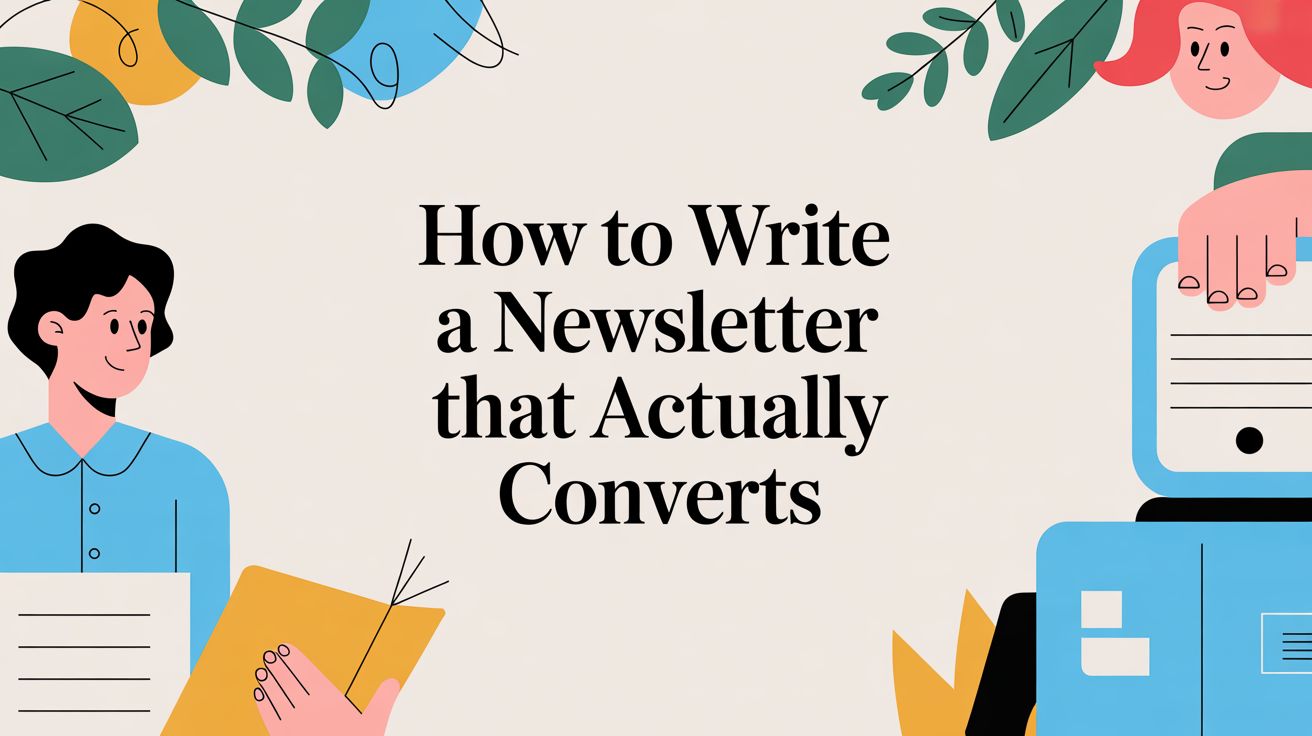
How to Launch a Product Online: A Growth Playbook Rooted in Consumer Psychology

Tossing a new product onto your online store and hoping for the best isn't a launch—it's a gamble. A real launch is a carefully orchestrated event, one that builds a groundswell of excitement and turns potential buyers into loyal customers from day one. It’s less about the product itself and more about the story you tell and the anticipation you build before it even goes live.
This guide is your playbook. We're going to walk through the entire process, from validating your market and building pre-launch hype rooted in consumer psychology to nailing launch day and scaling afterward for maximum ROI.
Your Blueprint for a Modern Online Product Launch
Think of a successful launch as a strategic map, not just a to-do list. It’s a deliberate sequence of moves designed to build demand, connect with the right people, and create a shopping experience so compelling that it drives sales the second you go live. This isn't just about a one-day sales spike; it's about setting up a new product to become a long-term revenue driver for your brand.
The online marketplace is more crowded than ever. The global e-commerce market is expected to hit around $6.8 trillion in sales by 2025, an increase of about 8.37% from 2024. That growth is more than double the rate of brick-and-mortar retail, highlighting both the massive opportunity and the fierce competition you're up against. You can dig into more of these e-commerce statistics to see how they're shaping the game for merchants.
To cut through the noise, your launch needs to be built on a solid understanding of behavioral economics and what makes consumers act.
The Core Phases of a Successful Launch
A modern product launch isn't a single moment; it's a campaign spread out over several stages, each designed to tap into powerful psychological triggers. The whole point is to create so much anticipation and urgency that customers are lining up, ready to buy the moment your product is available. When you do it right, you can avoid those margin-killing launch day discounts and build a much more engaged, long-term customer base.
This flow breaks down the essential stages: figuring out who you're selling to, building a waitlist of people who can't wait to buy, and setting yourself up for growth long after the launch dust settles.
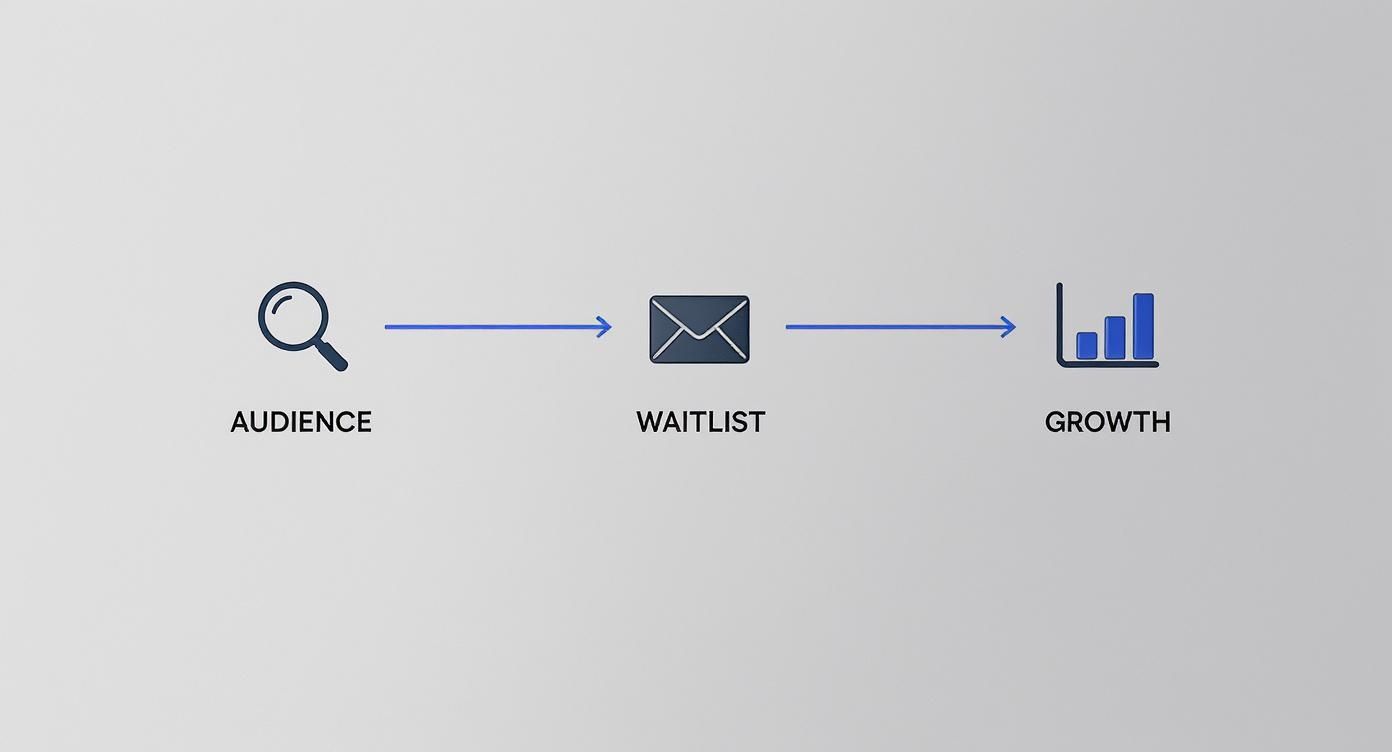
This isn’t just a random series of steps. It’s a strategic move from broad market awareness to targeted, profitable growth, with data guiding you at every turn.
To give you a clearer picture, I've broken down these stages into a simple table that outlines what you should be focused on and when.
Core Phases of a Successful Product Launch
This table summarizes the essential stages involved in launching a new product online, from the initial spark of an idea to optimizing for long-term success.
| Launch Phase | Key Objective | Primary Activities |
|---|---|---|
| Pre-Pre-Launch | Validate the product idea and identify the target audience. | Market research, competitor analysis, customer surveys, defining the ideal customer profile. |
| Pre-Launch | Build hype and capture a high-intent audience. | Creating a waitlist, running teaser campaigns, engaging on social media, influencer outreach. |
| Launch Day | Maximize initial sales velocity and create a sense of event. | Announcing the launch to your waitlist, running live promotions, monitoring site performance. |
| Post-Launch | Maintain momentum and gather crucial feedback. | Collecting customer reviews, analyzing sales data, planning follow-up marketing campaigns. |
Each phase builds on the last, creating a powerful snowball effect that can turn a simple product release into a major brand moment.
Actionable Takeaway: A successful product launch isn't about having the best product; it's about executing the best process. It all comes down to your ability to build an audience that wants your product before it's even available, using principles like social proof and anticipation to drive that initial sales wave. This guide will walk you through each critical phase.
Mastering Your Pre-Launch Strategy
A product's success is often decided long before it ever hits the digital shelf. The pre-launch phase is your proving ground—it’s where you validate your idea, get crystal clear on who you're selling to, and build a community of high-intent buyers who are literally waiting to give you their money.
This isn't just about collecting a few emails. It's about manufacturing a powerful sense of anticipation that translates into real revenue the second you go live.
With 85% of global consumers now shopping online, the audience is massive. But so is the competition. The hard truth is that new product failure rates have historically hovered between 70-80%. The usual culprits? A weak market fit or, more often, a total failure to connect with an audience before asking for the sale.
Identifying Your Ideal Customer
Before you can create any real buzz, you have to know exactly who you're trying to talk to. For now, forget the expensive analytics software. Let's get practical.
Start by digging into your direct competitors. Who are they targeting? More importantly, read their customer reviews—the good, the bad, and the ugly. The complaints are often a goldmine, pointing directly to unmet needs and frustrations your product can solve. This isn’t just a feature checklist; it’s about tapping into the emotional triggers that drive someone to buy.
Then, turn to social media. It's a direct line to your future customers.
- Run simple polls: Use Instagram Stories or X to ask direct questions. A skincare brand, for instance, could poll followers on their preferred ingredients or packaging. You get instant, actionable feedback.
- Be a fly on the wall: Lurk in relevant Reddit subreddits or Facebook Groups where your target audience hangs out. Pay attention to how they talk, what they complain about, and what they get excited about. This is free, unfiltered market research.
This process gives you invaluable, real-world insights that will shape your messaging and ensure your product actually connects with the right people.
Actionable Takeaway: Think of your pre-launch audience as a live focus group, not just an email list. When you involve them early and ask for feedback, they feel like co-creators. That sense of ownership builds a kind of loyalty that no ad campaign can buy.
Building Anticipation and Your Waitlist
Once you have a clear picture of your ideal customer, the mission is simple: build an email and SMS list of people who can't wait to buy. This list is your single most valuable launch asset. It gives you a direct line to your hottest leads, completely bypassing the unpredictable social media algorithms.
The goal here is to cultivate an "insider" feeling.
A dedicated pre-launch landing page is your best friend. Keep it simple: a killer headline that speaks directly to your customer's biggest problem, a slick product teaser image, and a can't-miss call-to-action to join the exclusive waitlist. For Shopify store owners, this is as easy as customizing a password-protected page or using a simple page builder app.
Now, you need to drive traffic to that page with a multi-channel teaser campaign.
- Share behind-the-scenes content: Post glimpses of the design process, packaging prototypes, or a peek at manufacturing on Instagram Stories or TikTok. This stuff builds authenticity and makes your audience feel like they're part of the journey.
- Leverage influencer teasers: Partner with a handful of micro-influencers who genuinely align with your brand. Send them early samples for "first look" posts or unboxing videos, but tell them not to reveal everything. It's all about creating curiosity and social proof.
- Run a countdown campaign: Use email and SMS to tell a story. Send weekly updates that reveal a new feature, a hidden benefit, or a piece of the product's backstory. For more on this, our guide on how to create anticipation for product launches goes deep on these strategies.
This isn't just about collecting emails; it's a methodical approach to community building. By the time launch day arrives, you won't be shouting into an empty room. You'll be dropping a product for an engaged audience that's been waiting for your announcement.
Engineering a High-Revenue Launch Day
Launch day is where all your prep work meets human psychology. This isn't just about flipping a switch and hoping for the best; it's your playbook for maximizing sales the second you go live by understanding what actually drives people to act now. The goal is to create an event so compelling that your waitlist converts in a massive wave, proving strong market demand and giving your product incredible initial momentum.
Forget those generic, "set it and forget it" countdown timers. We've all seen them, and customers have learned to ignore them. A truly high-revenue launch day is about orchestrating a series of psychological triggers that make buying feel like an exciting, can't-miss opportunity. It’s about turning a simple transaction into a memorable brand experience.
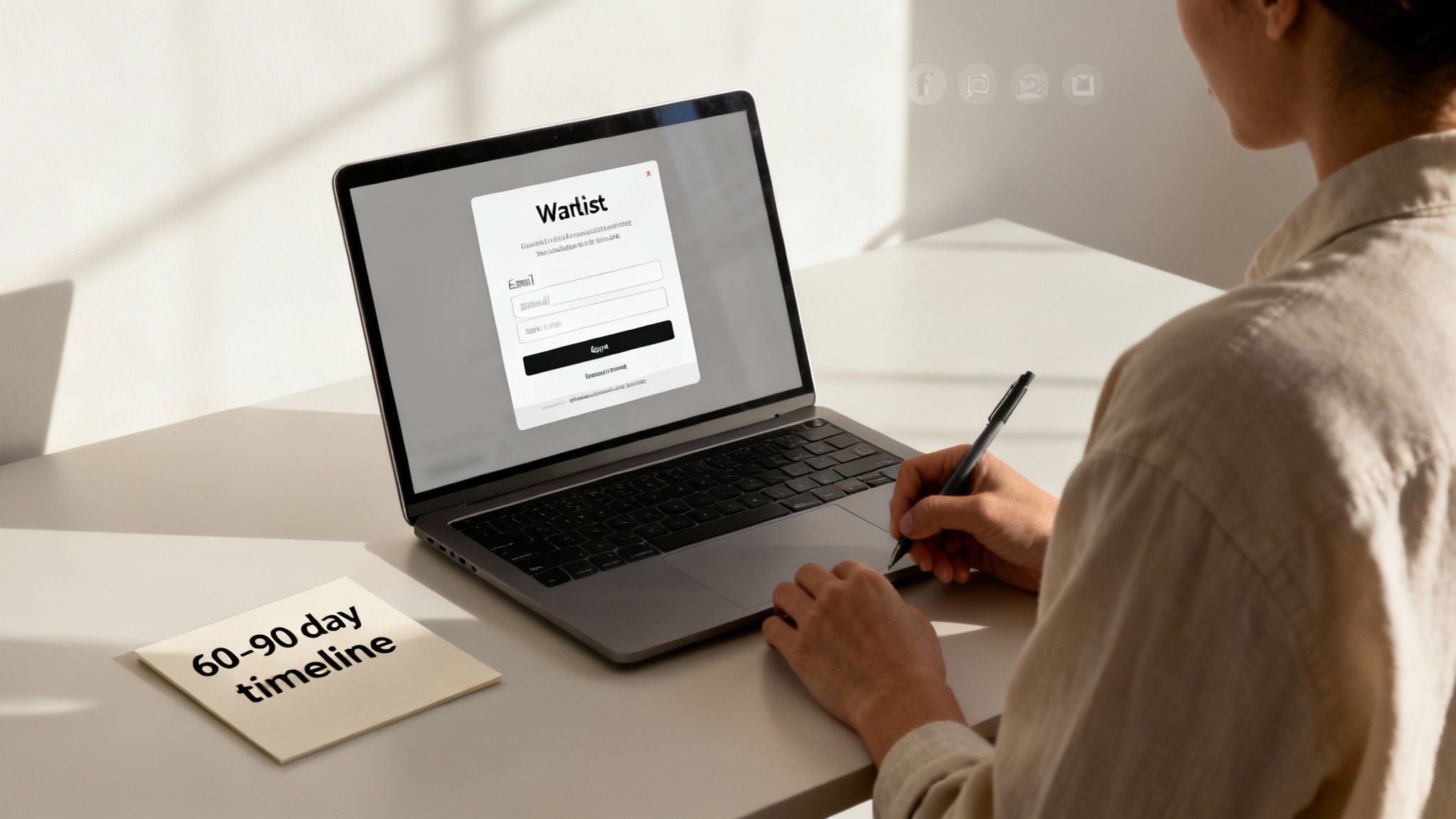
When you nail this, you also protect your profit margins. Instead of slashing prices with brand-damaging discounts, you're rewarding engagement and speed—a much smarter way to boost your ROI.
Moving Beyond Basic Timers with Behavioral Science
The average ecommerce cart abandonment rate is a painful 70%. That number is a flashing red light telling us that just getting a customer to the checkout page isn't enough. Basic timers create a vague sense of urgency, but they rarely have the psychological punch to overcome that last-minute hesitation.
This is where you need to get smarter by applying principles like FOMO (Fear Of Missing Out) and scarcity in a more sophisticated way. Instead of just showing a clock, you build a dynamic environment where a customer's action—or inaction—has real consequences. The focus shifts from a generic deadline to a personal opportunity. We dive deep into this approach in our guide to scarcity marketing.
A ranked offer, for example, is a powerhouse tactic. It taps into our natural drive for competition by rewarding the fastest people with the best deals. Maybe the first 100 buyers get the product for a special price, the next 500 get a slightly different offer, and so on. This structure lights a fire under people far more effectively than a simple "24 hours left!" banner ever could.
Implementing Advanced Urgency Tactics
To really engineer a high-revenue launch, you need tools that are wired for consumer psychology. This means stepping away from clunky, manual campaign management and embracing automated, trigger-based systems that create a responsive and genuinely exciting customer journey.
Here are a few tactics you can put into action:
- Limited-Time Product Drops: Release your new product in controlled, time-gated batches. Announce that only a specific number of units will be available in the first "drop." This creates real scarcity, drives a ton of immediate traffic, and helps you manage inventory with surgical precision—something that's mission-critical for Shopify Plus merchants handling huge order volumes.
- Dynamic Scarcity Banners: Use banners that update in real-time to show inventory levels or how many people are looking at the product. A message like "Only 27 left in stock" or "15 other people are looking at this right now" combines social proof and urgency into one powerful nudge.
- Tiered Launch Access: Give different segments of your audience early access at different times. Your VIP email list might get in an hour before your general list, who get access before you announce it on social media. This is a brilliant way to reward loyalty and create multiple "launch moments," each with its own spike of urgency.
Key Insight: The line between sophisticated psychology and manipulation is authenticity. These advanced urgency tactics are most powerful when they're tied to real-world constraints, like actual inventory limits or a genuine tiered rewards structure. This builds trust while creating a powerful reason to act immediately.
Urgency Marketing Tactics Comparison
Many brands stop at the most basic urgency tactics, leaving a ton of revenue on the table. The real impact comes from using more advanced, psychology-driven methods that tap into behavioral triggers. Here's a quick look at the difference.
| Tactic | Basic Approach (e.g., Simple Timers) | Advanced Approach (e.g., Behavioral Triggers) | Primary Business Impact |
|---|---|---|---|
| Countdown | A generic "Sale Ends In..." timer shown to everyone. | A personalized timer that starts when a user first visits the page or claims an offer. | Increases relevance and personal stakes for the individual shopper. |
| Scarcity | A simple "Limited Stock" message on a product page. | A dynamic, real-time counter showing "Only 12 left!" or tiered offers that disappear as they're claimed. | Creates authentic FOMO and accelerates the purchase decision. |
| Exclusivity | A generic "VIPs shop first" email blast. | A multi-tiered launch with staggered access times for different customer segments (e.g., loyalty members, SMS subscribers). | Rewards loyalty, builds community, and creates multiple conversion spikes. |
| Social Proof | Displaying static product reviews. | Live notifications showing "Someone in Austin just bought this!" or "25 people are viewing this now." | Validates the purchase decision in real-time, reducing hesitation. |
As you can see, the advanced approach isn't just a gimmick; it's a strategic layer designed to align with how people actually think and act, leading to significantly better conversion rates and a more memorable launch event.
Your Shopify Launch Day Tech Stack
A monster launch day also hinges on a rock-solid technical foundation, especially for Shopify store owners who are about to get hit with a tidal wave of traffic. Your site has to be fast, stable, and ready for thousands of simultaneous checkouts.
First things first, make sure your Shopify theme is optimized for performance. Run speed tests before launch day and fix anything that's slowing you down. For Shopify Plus brands, tools like Launchpad are a lifesaver for scheduling and automating launch day events like theme changes, product releases, and promotions.
Next, get your core marketing automation tools locked in.
- Klaviyo & SMS Platforms: Your launch day email and SMS campaigns should be written, designed, and scheduled well in advance. Build out a multi-step flow that announces the launch, reminds those who haven't bought yet, and sends a final "last chance" notification. These automated sequences are your digital sales force on launch day.
- Urgency Marketing with Quikly: Instead of trying to patch together multiple apps for timers, banners, and popups, a platform like Quikly integrates all of these "Moments" into one cohesive system. You can build and automate a ranked offer campaign that speaks directly to your email and SMS lists, creating a seamless and exciting journey from their inbox to your checkout page. It replaces a fragmented, manual mess with a sophisticated, automated revenue engine.
Building the Perfect Product Launch Page
Your product page is your digital storefront, your top salesperson, and your entire conversion engine rolled into one. When launch day hits, it's the single most critical asset you have. A well-crafted page doesn't just show off a product; it walks a visitor from initial curiosity all the way to a confident purchase, using smart psychology to get the sale.
Think of this page as the grand finale of your pre-launch hype. Every bit of anticipation you've built up leads right here. The average ecommerce conversion rate floats around a pretty meager 2.5%. That means for every 100 visitors, 97 of them are bouncing. Your launch page is the best weapon you have to fight that stat and turn your hard-earned traffic into actual sales.
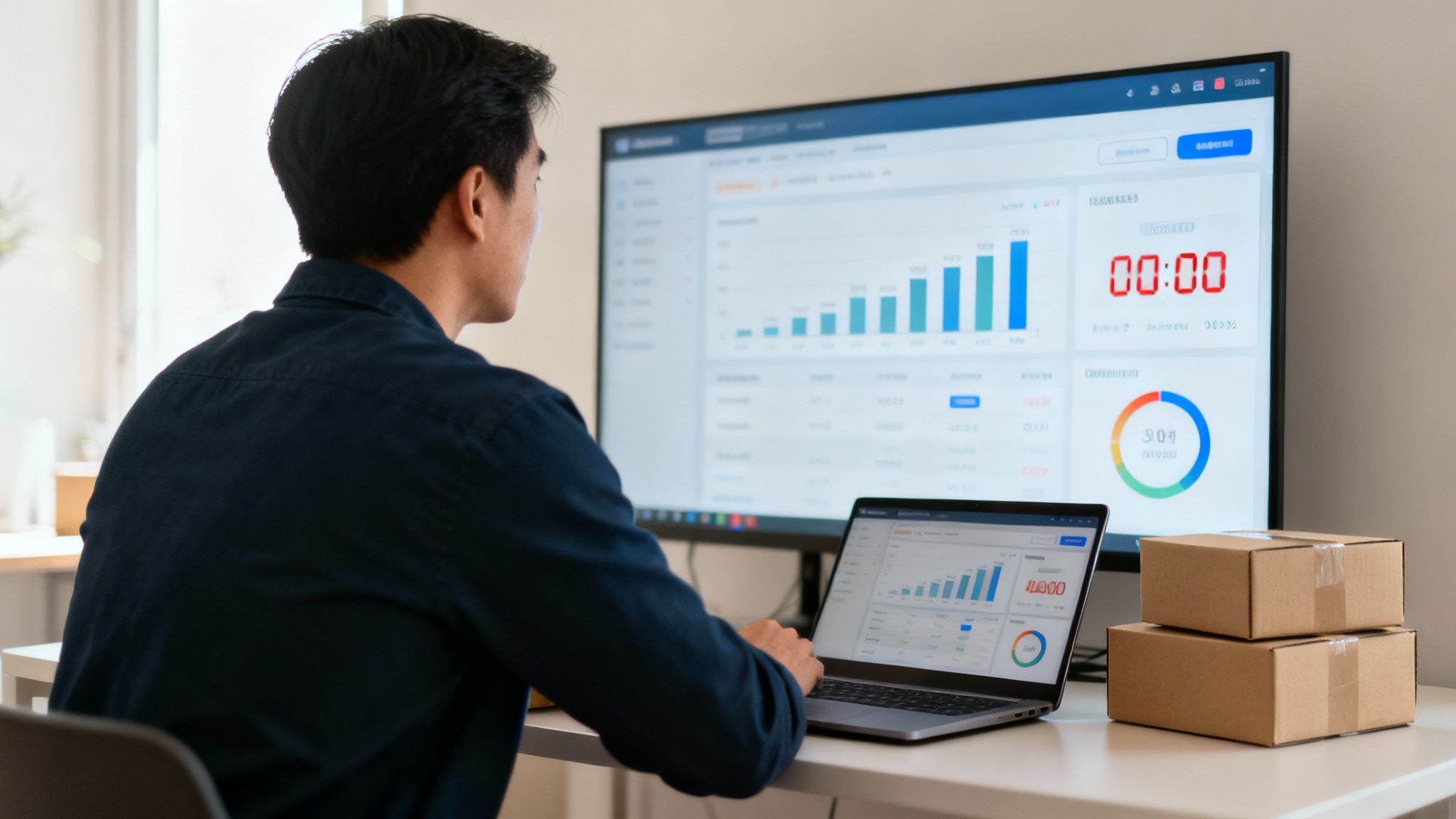
Core Components of a High-Revenue Page
A killer launch page is like a finely tuned machine. Each part has a specific job: to knock down a customer's hesitation. It needs to answer their questions before they even ask, build immediate trust, and create a real reason for them to act right now. Your page has to be more than just pretty—it has to be persuasive.
Let's break down the absolute must-haves:
- Compelling Visuals: High-quality photos and videos aren't optional anymore. Show the product from every angle, in real-world situations, and actually being used. A quick, dynamic video can boost conversions by showing value in a way static images just can't match.
- A Clear Value Proposition: Your headline and opening sentence have to immediately answer, "What's in it for me?" This isn't the place to list features. It’s about clearly stating the benefit and how you're solving a real problem for your customer.
- Persuasive Product Descriptions: Forget the dry technical specs. Use language that helps the customer picture themselves using—and loving—your product. Get ahead of their objections and answer their questions right in the copy.
- Strong Social Proof: This is where you bring in the power of the crowd. Weave in customer testimonials, user-generated content (UGC) from places like Instagram, and any press you've gotten. Seeing that other people have already bought and are happy with a product is a huge psychological nudge.
For a deeper look into what makes a page convert, check out our guide on building a https://hq.quikly.com/blog/website-that-converts traffic into loyal customers.
Leveraging Technology for an Enhanced Experience
In today's market, a simple, static page sometimes doesn't cut it. Think about adding innovative features that help customers truly visualize the product. For fashion and accessory brands, for example, a game-changer is implementing virtual dressing rooms and AI try-on technology. These interactive tools close the gap between shopping online and trying something on in-store, which seriously boosts shopper confidence and conversion rates.
Actionable Takeaway: Your product page’s main job is to eliminate uncertainty. Every single element—from the words you choose to the quality of your images and the strength of your social proof—should work together to make hitting that "Add to Cart" button feel like the most obvious, logical next step.
Shopify-Specific Enhancements for Launch Day
If you're running on Shopify, you've got a massive toolbox ready to go. You can build a launch page that not only looks incredible but also performs like a champ under the pressure of a traffic spike. The goal is simple: create a beautiful, functional, and fast-loading page that can handle all the visitors you've worked so hard to attract.
Here are a few practical tips for Shopify store owners:
- Utilize Custom Sections: Modern Shopify 2.0 themes are incredibly flexible. You can create custom sections for testimonials, detailed feature callouts with icons, and embedded videos. This breaks up the wall of text and makes the information much more engaging and easy to digest.
- Integrate Review Apps: Apps like Judge.me or Loox are perfect for this. They let you seamlessly pull in photo and video reviews, putting powerful, authentic social proof right where people need to see it most—next to the buy button.
- Optimize for Mobile-First: Get this right. The majority of your launch day traffic is going to come from a smartphone. You have to rigorously test your page's layout, load speed, and the entire checkout process on mobile. Make sure buttons are easy to tap and that all your content is perfectly readable without any awkward pinching or zooming.
By focusing on these psychological triggers and technical details, your product page stops being just another catalog entry. It becomes a strategic asset, built from the ground up to maximize revenue from the very first person who lands on it.
Scaling Profits with Post-Launch Optimization
A massive product launch is an incredible feeling, but it's not the finish line. It's the starting pistol. That initial spike in sales is exhilarating, but the real, sustainable profit comes from what you do in the days and weeks that follow.
This is where the hard work of post-launch optimization begins. It’s all about turning that first wave of excitement into predictable, long-term revenue by digging into the data and, most importantly, listening to your brand-new customers. Forget guessing what worked—it's time to dissect the launch, understand exactly how people behaved, and build a powerful feedback loop to drive repeat business.
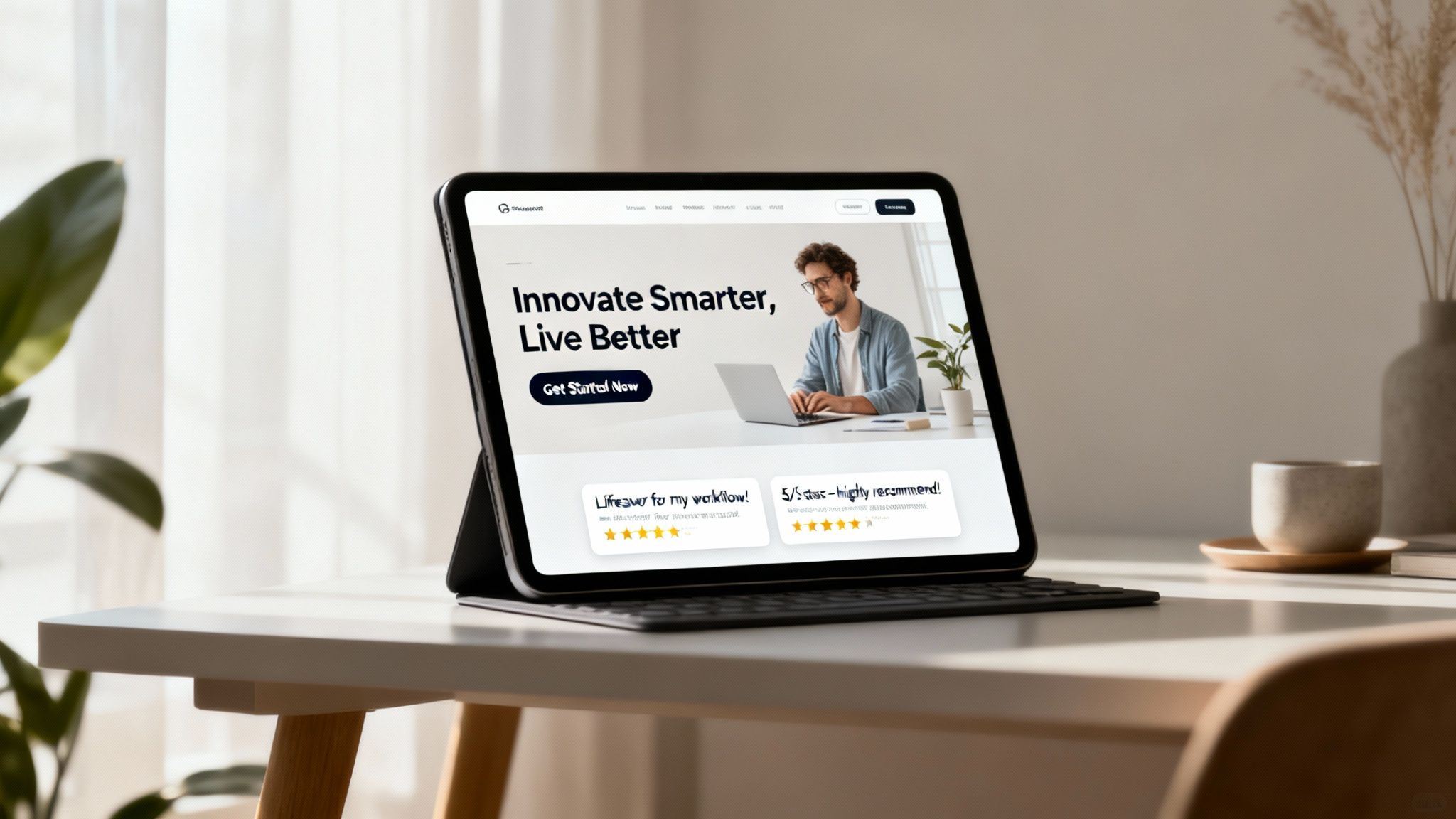
Key Metrics Beyond Initial Revenue
Your launch day sales number is exciting, but it’s just one piece of a much larger puzzle. To really get a handle on performance and figure out how to scale, you need to look at the metrics that actually reveal the health of your business.
- Customer Acquisition Cost (CAC): How much did you spend to get each new customer? It’s a simple question with huge implications. If your CAC is sky-high, a launch that looks successful on the surface could actually be burning through your profits.
- Conversion Rate by Traffic Source: Don't settle for your overall conversion rate. You need to get granular. What if your email list converted at a whopping 10%, but your Instagram ads barely hit 1%? That data tells you exactly where to put your marketing dollars next.
- Customer Lifetime Value (LTV): This is the holy grail for long-term growth. A high LTV means you’re not just making one-off sales; you’re building a base of loyal, repeat customers who will fuel your revenue for months, even years, to come.
When you track LTV against your CAC, you get a crystal-clear picture of profitability. A healthy e-commerce business is one where the lifetime value of a customer is significantly higher than what it cost you to bring them in the door.
Gathering Feedback and Retargeting Strategically
The period right after your launch is a golden opportunity to learn from real buyers and recapture sales that almost slipped away. Your mission is to kick off a continuous cycle of feedback and engagement.
First, start systematically collecting customer feedback. Set up an automated email flow using a tool like Klaviyo to send out post-purchase surveys. Don't be shy—ask direct questions about their experience, what they love about the product, and where you can improve. These insights are pure gold for your next production run or product update.
At the same time, fire up a retargeting campaign aimed squarely at people who visited your site on launch day but didn't pull the trigger. These aren't cold leads; they were interested enough to show up. Use dynamic ads to show them the exact product they were looking at, maybe with a few of the glowing customer testimonials you've already started collecting. It's a simple reminder that can bring a surprising amount of that "lost" revenue back.
Adapting to Modern Consumer Behavior
To scale your brand today, your post-launch strategy has to mirror how people actually shop. The world has gone mobile and social, completely reshaping the customer journey.
Think about it: by 2025, mobile commerce is expected to make up nearly 59-73% of all global e-commerce sales. And social commerce? It's on track to become a $1.17 trillion channel. This means your optimization can't just live on your website anymore.
To truly unlock growth, mastering multi-channel e-commerce integration is essential. It’s about creating a seamless, consistent experience for your customers wherever they are—from social media feeds to their inbox—and turning those initial launch-day buyers into a thriving community of repeat purchasers.
Common Product Launch Mistakes to Avoid
Knowing the right way to launch a product online is one thing, but knowing the pitfalls that can quietly sink your efforts? That's the real key. Even with a brilliant strategy, a few common mistakes can completely undermine all your hard work. Let's get past the obvious stuff and dig into the errors that actually hit your revenue and brand perception.
One of the most damaging missteps is completely botching inventory flow. It's not just about running out of stock—that's a problem, sure—but it's about the frustrating customer experience it creates. Instead of a single "all-or-nothing" drop, think about a tiered launch. This approach helps manage inventory and makes the whole journey feel more exclusive. You could offer a limited quantity to your VIP SMS list first, then open it up to email subscribers, and finally have a public release. This protects your stock levels and makes your most loyal fans feel special.
Setting Unrealistic Goals and Going Silent
Another classic mistake is setting vague or vanity-driven sales goals. Just aiming for a massive revenue number without a clear plan for metrics like conversion rate by channel or customer acquisition cost (CAC) is a recipe for disappointment. A successful launch isn't just a big sales figure; it's a profitable one where your unit economics actually make sense.
Your launch day is the beginning, not the end, of a customer relationship. Going silent post-purchase is a massive missed opportunity to build loyalty and get crucial feedback for your next big thing.
Just as bad is going quiet after the launch. The moment a customer hits "buy" is when the real relationship starts. If you fail to follow up with order confirmations, shipping updates, and a simple "how do you like it?" email, you're leaving new customers in the dark. A simple automated email sequence through a tool like Klaviyo can turn a one-time buyer into a repeat customer for life.
Putting All Your Eggs in One Traffic Basket
Finally, relying on a single channel for all your promotion is a huge gamble. I've seen brands go all-in on Instagram ads or a single influencer partnership, only to have their entire launch stall when an algorithm changes or a campaign flops. Don't do it.
A diversified traffic strategy is basically your launch insurance policy.
- Email & SMS: These are your owned channels. They give you a direct, reliable line to your most engaged audience.
- Paid Social: Use platforms like Facebook and TikTok to reach new, highly targeted segments of people who don't know you yet.
- Organic Content: Your blog posts and SEO efforts are what will keep capturing interest long after the initial launch hype has faded.
By getting ahead of these challenges, you can build a launch plan that's not just more resilient and profitable, but one that actually sets the stage for long-term, sustainable growth.
Got Questions About Your Product Launch? We've Got Answers.
Launching a new product online for the first time? It's natural to have a million questions running through your head. Let's tackle some of the most common ones that merchants wrestle with during this make-or-break process.
How Much Should I Actually Budget for a Product Launch?
This is the big one. A good, solid benchmark is to set aside 20-30% of your product's projected first-year revenue specifically for your launch marketing. This isn't just for ads; it's the whole shebang—from pre-launch influencer seeding and content creation to your launch-day ad spend and promotional pushes.
Don't just throw that money at anything that moves. Focus your budget on the channels that bring you the highest ROI, not just the most clicks. Your best bet is always building up your owned audiences, like your email and SMS lists. These are your people, and they consistently deliver the most profitable returns when you have something new to share.
What’s the Sweet Spot for a Pre-Launch Timeline?
For most brands selling directly to consumers, a 60 to 90-day pre-launch window is the magic number. It gives you just enough runway to build genuine hype and a solid waitlist without your audience getting bored and wandering off.
A timeline that's too short won't give you enough time to build real anticipation and social proof. But drag it out too long, and you risk campaign fatigue. You're looking for that perfect, consistent drumbeat of communication that gets people more and more excited as launch day gets closer.
How Do I Score My First Customer Reviews?
Those first few reviews are pure gold. They build immediate trust and help push hesitant new buyers over the edge. The best way to get them is to just ask your earliest customers directly.
Here are a couple of simple, effective ways to do it:
- Sweeten the deal: Offer a small, simple thank you—like a modest discount on their next purchase—to the first 50 buyers who take a minute to leave an honest review.
- Put it on autopilot: Use a tool like Klaviyo to automatically send a follow-up email a week or two after the product is delivered. Just ask for their honest feedback and link them straight to the review section on your Shopify product page to make it dead simple.
Ready to turn your next launch from just another product drop into a record-breaking sales event? Quikly is the expert in urgency marketing science, giving you the playbook to tap into proven consumer psychology with sophisticated "Moments" that enhance banners, popups, and the entire shopper journey. See how Quikly can help you engineer your most successful launch yet.

The Quikly Content Team brings together urgency marketing experts, consumer psychologists, and data analysts who've helped power promotional campaigns since 2012. Drawing from our platform's 70M+ consumer interactions and thousands of successful campaigns, we share evidence-based insights that help brands create promotions that convert.
